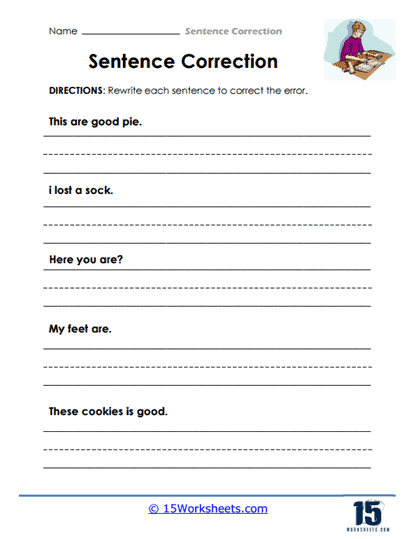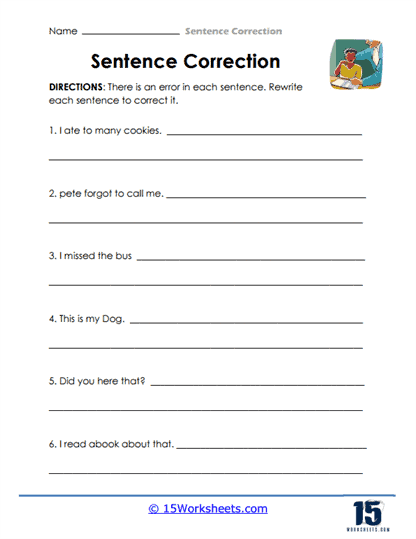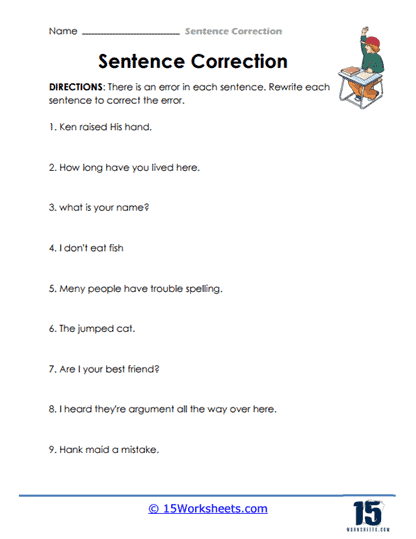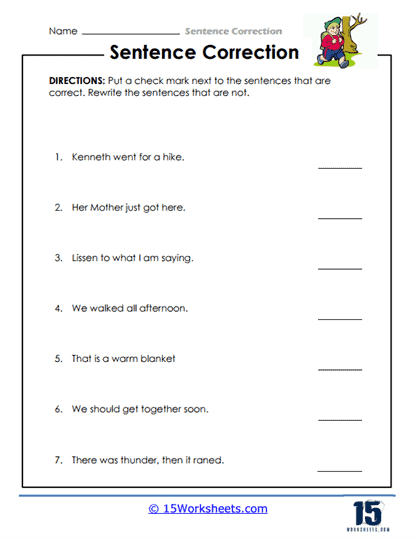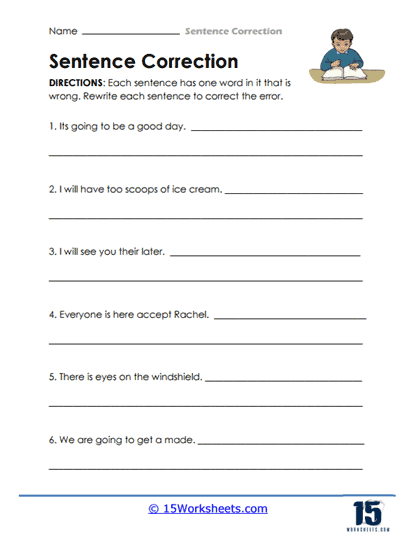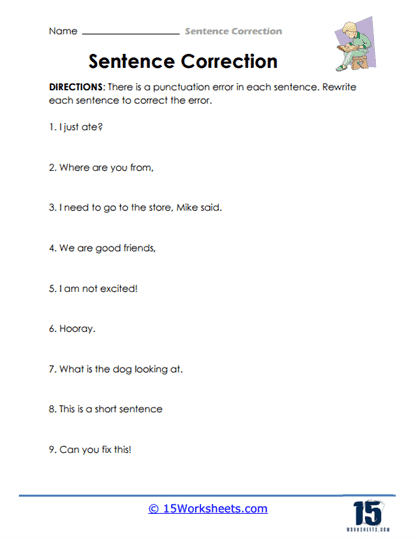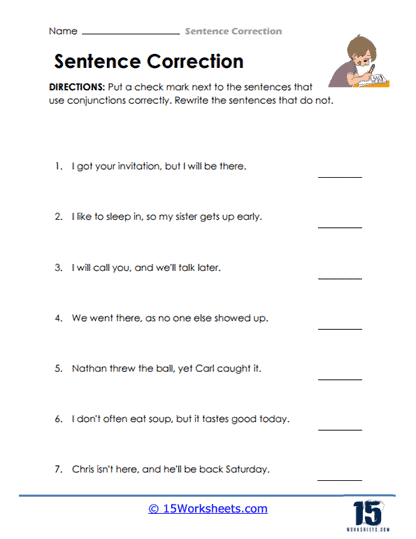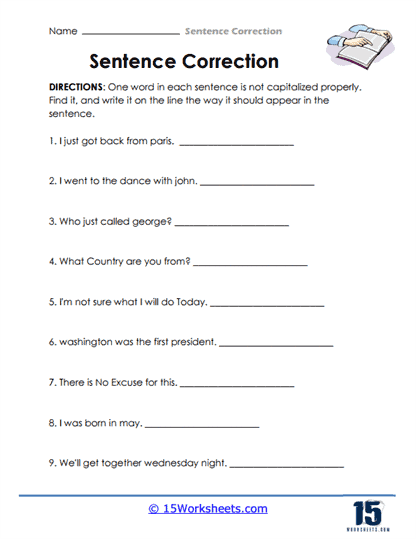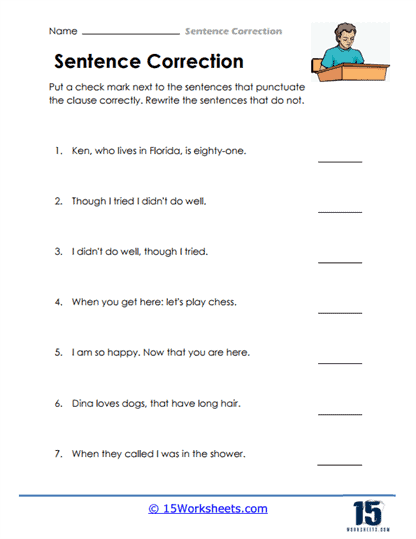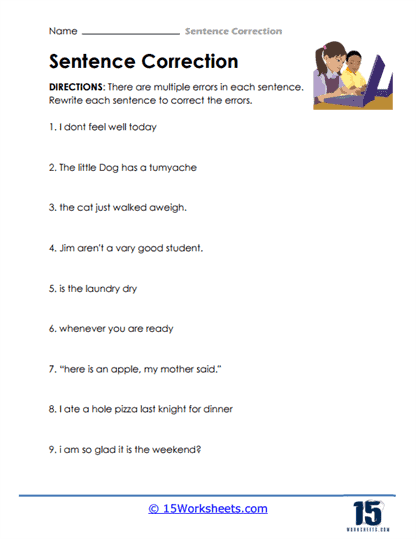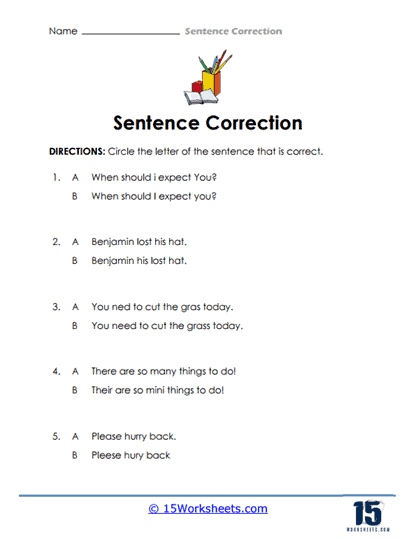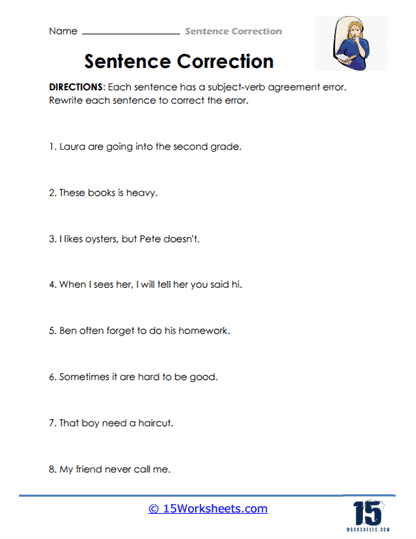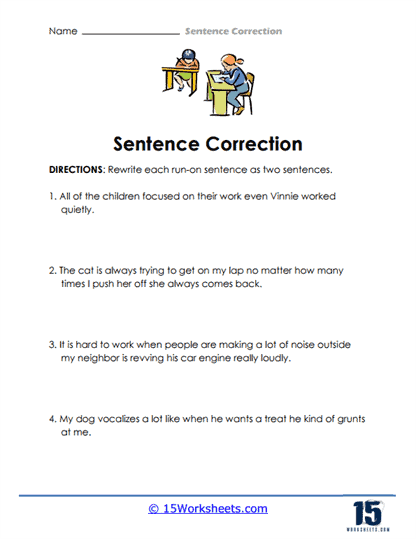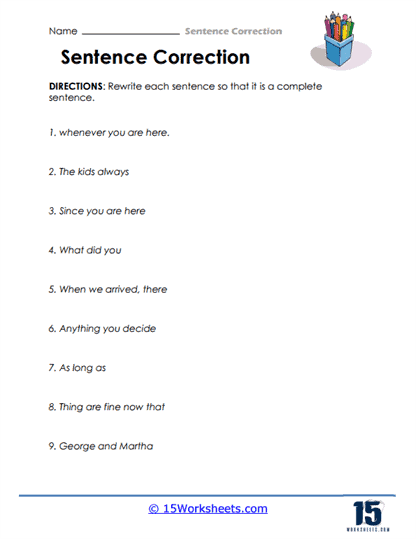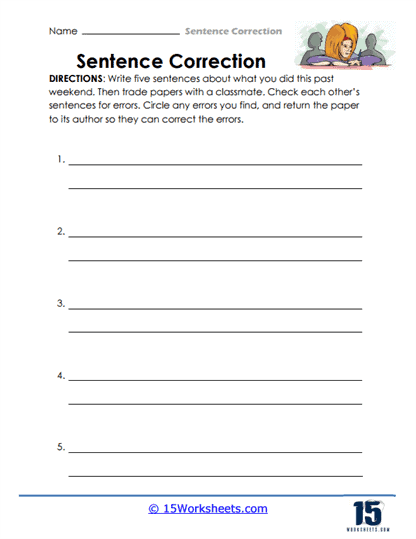Sentence Correction Worksheets
All About These 15 Worksheets
Sentence correction worksheets will help students improve their grammar, syntax, punctuation, and overall writing skills by identifying and correcting errors in sentences. These worksheets present sentences that contain common mistakes, such as incorrect verb tense, misplaced punctuation, awkward word order, or subject-verb agreement issues. Students are tasked with identifying the errors and rewriting the sentences correctly, which helps them sharpen their proofreading and editing skills. Sentence correction worksheets are suitable for students at various learning levels and are used to reinforce foundational grammar concepts, improve writing clarity, and encourage careful attention to detail in both formal and informal writing.
These worksheets serve an important role in helping students develop their language arts skills. Writing is a complex process that requires not only creativity but also a solid grasp of grammar and sentence structure. By working through sentence correction exercises, students learn to recognize common errors that can undermine the quality of their writing. They also develop a better understanding of how to construct clear, grammatically correct sentences. This skill is crucial for success in academic writing, professional communication, and even creative projects, as it ensures that the intended message is conveyed clearly and accurately to the reader.
How They Can Help
This series of worksheets are highly effective in improving writing skills by teaching students to focus on the finer details of sentence construction. When students are presented with flawed sentences and asked to correct them, they must engage in critical thinking about grammar rules and writing conventions. This practice helps reinforce their understanding of key language concepts, such as proper verb tense, pronoun usage, and punctuation placement. Over time, students become more proficient at applying these rules in their own writing, leading to clearer, more polished sentences. For instance, if a student frequently misplaces commas in their writing, a worksheet focusing on comma usage can help them internalize the correct way to punctuate complex sentences.
In addition to writing skills, these worksheets are excellent for developing proofreading and editing abilities. Proofreading requires the ability to spot errors quickly and efficiently, while editing involves improving the clarity and flow of a sentence or paragraph. By regularly working on sentence correction exercises, students hone their ability to identify mistakes in grammar, spelling, and syntax, which makes them better at reviewing their own writing as well as the work of others. For example, a worksheet might present sentences with subtle errors, such as a missing article or misplaced modifier, and students will need to scrutinize the sentences closely to make the necessary corrections. This practice encourages careful reading and helps students develop an eye for detail, which is essential for producing well-written, error-free work.
These worksheets also help students enhance their language arts skills, including their understanding of the rules that govern language. Sentence correction exercises often highlight specific grammar topics, such as subject-verb agreement, sentence fragments, run-on sentences, and more. For example, a worksheet might focus on correcting run-on sentences by teaching students how to properly use conjunctions or punctuation to separate independent clauses. By consistently practicing with these worksheets, students not only improve their technical writing abilities but also deepen their understanding of how language functions, which ultimately makes them better communicators across the board.
Types of Exercises
Sentence correction worksheets offer a range of exercises designed to target different aspects of writing and grammar. One common type of exercise involves identifying and correcting grammatical errors within a single sentence. For instance, students might be given a sentence like, “She don’t like running in the rain.” The student would then identify the error-incorrect verb agreement-and rewrite the sentence correctly: “She doesn’t like running in the rain.” These exercises help students practice fixing common mistakes such as subject-verb agreement, verb tense shifts, and pronoun errors, reinforcing the rules of grammar that they need to apply in their own writing.
Another type of exercise focuses on punctuation correction. In these activities, students are presented with sentences that contain missing or misplaced punctuation marks, such as commas, periods, or apostrophes. For example, a sentence like “Its a beautiful day lets go outside” has multiple punctuation errors: the contraction “It’s” needs an apostrophe, and there should be a period or a semicolon separating the two independent clauses. By identifying these mistakes, students become more adept at using punctuation to clarify meaning and separate ideas in their writing.
In addition to grammar and punctuation, some sentence correction worksheets focus on sentence structure and syntax. These worksheets may contain sentences with awkward or unclear phrasing that students must rewrite to improve clarity. For example, a sentence like “The boy ran quickly down the street chasing after his dog in a hurry” could be rewritten as “The boy hurried down the street, quickly chasing his dog.” This type of exercise teaches students how to avoid redundancy, maintain parallel structure, and use concise language, all of which are essential for writing that is both engaging and easy to understand.
This series includes error correction within longer passages. Instead of focusing on single sentences, these exercises present students with a paragraph or short passage that contains multiple errors, and students must identify and correct the mistakes throughout the entire text. This approach not only helps students practice their grammar and editing skills in a more comprehensive context but also encourages them to think about how individual sentences work together to create cohesive, well-structured paragraphs. For example, a passage about a historical event might include errors in verb tense consistency, requiring students to ensure that all past events are described in the correct tense. This type of exercise is particularly useful for students working on more advanced writing, such as essays or research papers.
Another engaging type of exercise on sentence correction worksheets involves combining or rewriting sentences to improve flow and coherence. Students might be given two or more choppy, disconnected sentences and asked to combine them into a smoother, more sophisticated sentence. For example, two sentences like “The sun was setting. It was casting a warm glow over the landscape.” could be combined into “The setting sun cast a warm glow over the landscape.” This exercise helps students develop a sense of rhythm and style in their writing, teaching them how to vary sentence lengths and structures for a more polished effect.
The Basics of Correcting Sentences
To correct sentences, you need to identify and address any errors or issues that affect their clarity, grammar, punctuation, or structure. Here are four examples of how to identify and correct some very common errors:
1. Subject-Verb Agreement
Incorrect sentence – The dogs barks loudly.
Correction – The dogs bark loudly.
Explanation – In the original sentence, the subject “dogs” is plural, but the verb “barks” is singular. They should agree in number, so we change the verb to its plural form, “bark.”
2. Punctuation Errors
Incorrect sentence – I love to swim it’s my favorite activity.
Correction – I love to swim. It’s my favorite activity.
Explanation – The original sentence is a run-on sentence without proper punctuation. We separate the two independent clauses into separate sentences by adding a period after “swim” or use a semicolon to join them correctly.
3. Capitalization Errors
Incorrect sentence – i went to paris for vacation.
Correction – I went to Paris for vacation.
Explanation – In the original sentence, the pronoun “I” should be capitalized, and the proper noun “Paris” should also start with a capital letter.
4. Sentence Fragments
Incorrect sentence – Playing soccer in the park.
Correction – I enjoy playing soccer in the park.
Explanation – The original sentence is a fragment because it lacks a subject or verb. By adding the pronoun “I” as the subject and the verb “enjoy,” we transform the fragment into a complete sentence.

